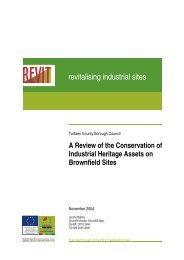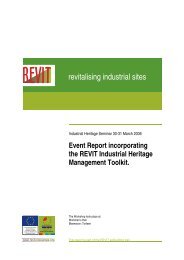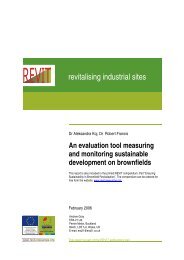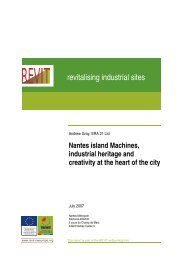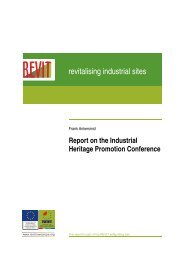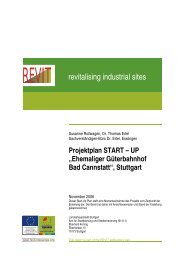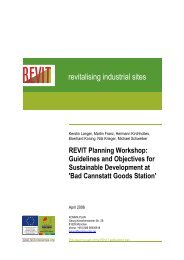DG State Aid – Control and Regeneraton of Deprived Urban ... - REVIT
DG State Aid – Control and Regeneraton of Deprived Urban ... - REVIT
DG State Aid – Control and Regeneraton of Deprived Urban ... - REVIT
You also want an ePaper? Increase the reach of your titles
YUMPU automatically turns print PDFs into web optimized ePapers that Google loves.
N546/A/2000<br />
Partnership support for regeneration (4): support for<br />
environmental regeneration<br />
The objectives <strong>of</strong> the scheme are the sustainable <strong>and</strong> balanced economic growth across the<br />
English Regions <strong>and</strong> the improvement <strong>of</strong> the physical environment. It <strong>of</strong>fers support for the<br />
reclamation <strong>of</strong> derelict or potentially derelict l<strong>and</strong> for “s<strong>of</strong>t end use” aimed at providing a<br />
public amenity. S<strong>of</strong>t end use is designed primarily to improve the environment, <strong>of</strong>ten by<br />
providing a cover <strong>of</strong> vegetation. Examples include public open space, nature conservation,<br />
<strong>and</strong> sport <strong>and</strong> recreation (for instance playing fields, but not sports centres). Any non-green<br />
development like small ancillary buildings <strong>and</strong> access roads will only be incidental to the<br />
main purpose <strong>of</strong> the scheme. In any event if reclamation is being taken forward with the aim<br />
<strong>of</strong> redeveloping the l<strong>and</strong> for “hard end use” such as <strong>of</strong>fices, industrial buildings, commercial<br />
leisure or housing this scheme may not be used.<br />
The scheme may be used for both publicly <strong>and</strong> privately owned l<strong>and</strong>. The circumstances<br />
where environmental regeneration works are carried out on privately owned l<strong>and</strong> may<br />
include situations where the local authority or regeneration body wishes to apply funding<br />
for preliminary works such as site investigation or where it wishes to acquire the l<strong>and</strong>. If<br />
a project carried out under the scheme results or might result in any but a minimal<br />
increase in the value <strong>of</strong> private l<strong>and</strong>, the owner must agree to pay an equivalent amount to<br />
the local authority or regeneration body as appropriate. All valuations will be exclusively<br />
undertaken by Independent Chartered Surveyors.<br />
All works to publicly owned l<strong>and</strong> will be subject to competitive tender in compliance<br />
with the Commission’s rules on public procurement. The same principle will be applied<br />
to privately owned l<strong>and</strong>, with the sole exception <strong>of</strong> the owner <strong>of</strong> the l<strong>and</strong> being also a<br />
developer. Also in such cases, all valuations will be undertaken exclusively by<br />
Independent Chartered Surveyors.<br />
Where the person responsible for pollution is clearly identified, that person must finance<br />
the remediation or the rehabilitation in accordance with the “polluter pays” principle. No<br />
gap funding will be provided under this scheme. It is assured under the scheme that in<br />
neither case will an undertaking receive any benefit, given the s<strong>of</strong>t end-use <strong>of</strong> the l<strong>and</strong><br />
concerned.<br />
The scheme will include the following forms <strong>of</strong> support (all valuations will be<br />
undertaken by Independent Chartered Surveyors):<br />
• acquisition <strong>of</strong> l<strong>and</strong>/buildings where it is necessary to acquire small parcels <strong>of</strong> l<strong>and</strong><br />
to provide a viable site for instance for public open space;<br />
• preparation <strong>of</strong> l<strong>and</strong>, including demolition, clearance, treatment <strong>of</strong> contamination,<br />
installation <strong>of</strong> services <strong>and</strong> drainage, l<strong>and</strong>scaping, fencing, lighting, etc.;<br />
• provision <strong>of</strong> basic infrastructure (it will only be provided in cases where its absence<br />
would preclude the site from being used for its intended purpose);<br />
• development/refurbishment <strong>of</strong> ancillary buildings like site huts, visitor centres;<br />
• sale or lease <strong>of</strong> l<strong>and</strong>/buildings;<br />
• administration expenses necessarily incurred by a local authority or private<br />
l<strong>and</strong>owner in designing, supervising <strong>and</strong> managing a reclamation project.<br />
The activities listed above can either be carried out by a local authority, regeneration<br />
body by itself, with other public bodies, or with private sector commercial organisations,<br />
the latter only after securing agreement to any uplift in value created by the works to be<br />
paid to the regeneration body. Applicants must notify the regeneration body <strong>of</strong> any<br />
changes in the use <strong>of</strong> reclaimed l<strong>and</strong> within a ten year period following completion <strong>of</strong> the<br />
works. If such a change in use creates uplift in l<strong>and</strong> value, this amount becomes<br />
repayable to the regeneration body.<br />
39



